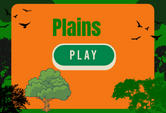Plains Facts Game Quiz Online
This a Plains Facts Game Quiz Online for students in 5th, 6th, 7th, 8th grades. Plains are vast areas of flat land. Some plains contain rivers and fertile land, hence have become breeding grounds for diverse species. Flood plains are wet for most of the year and contain a vibrant ecosystem. Some are being destroyed through draining for urban spaces. Some plains are relatively dry and fertile and have become areas designated for large agro-industrail scale farms. With these important roles plains play in our lives, why not take up some time to learn some interesting facts about plains. This game is interactive and students can use it to review at home or in the classroom.

Examples of Plains
A plain is a flat area of land with gentle slopes and low relief. Plains vary in size, from a few acres to hundreds of thousands of square miles. Examples of large plains include the Great Plains of North America and the Pyrenean Mountains on the Spanish-French border. Some hilly land is also considered a type of plain. Several countries in Asia and Europe have large plains, including the United States.Large farms
The vast expanse of the Great Plains is home to large farms and cattle ranches. This is one of the most fertile farmlands in the world. Wheat is a popular crop that thrives in these plains even without much rainfall. Cattle are also grazed in much of the plains. Large wind turbines are now being built on the plains. Farmers receive payments for their land from the power company.
Without the vast fertile plains around the world, large-scale industrial agriculture would not be possible.
Cattle ranches in the Great Plains
In the Great Plains that crisscross the United States and Canada, there are vast areas of cattle ranches. Some of them are large, mechanized ranches, while most are family owned and operated. Family-owned ranches are not heavily mechanized and their equipment usually consists of two or three older tractors, hay and tillage equipment, a heavy truck and trailers, and other miscellaneous items. Livestock are usually sold at the ranch, with contract sales and on-farm pickup. Therefore, these ranches have low capital costs.
The terrain is apartment, water storage capacity is high, and drainage is not a major problem. Pastures along the river and drainage basins generally respond well to fertilizer and tillage. On the other hand, upland pastures are often used for grazing. In addition, the fine sandy loam soils of these uplands are among the best in the Great Plains, making them ideal pastures.
The vastness of the Great Plains makes it not only a fascinating breeding ground for cattle, but also a great place for adventure driving.
Fertile land in plains
The soil in most agricultural plains is extremely fertile, thanks to deposits of silts from rivers. Farmers grow rice, wheat, and millets on these plains. The flatness makes them ideal for mechanized farming, and the grasslands provide good grazing for livestock. Although these types of land are highly vulnerable to erosion, they still provide a good growing environment. In addition, these areas are relatively low-lying and have few large obstacles like rocks that could obstruct tillage.
Floodplains have the potential to be extremely fertile, because the soils are so rich in organic matter and alluvial soil. Because of this, floodplains are ideal for growing crops and grazing livestock. However, it is also susceptible to erosion, which is a major cause of the decline of agricultural production in some plains. Therefore, these soils need to be tended properly to avoid erosion. Floodplains
Floodplains are mostly flat lands that contain water for most of the year. They harbor a rich biodiversity, but unfortunately they are being destroyed all over the world. If you are planning an urban development project, consider the benefits of floodplains before removing them. They can serve as agricultural croplands or settlement areas and provide clean water for irrigation and industry. In addition to these benefits, floodplains are also beneficial to human habitat.
Civilization and plains
Most of the great civilizations arose near plains. With these civilizations came religious practices that flourished for several centuries. Egyptian civilization arose along the Nile, and this river and its plains played a crucial role in its formation. Native Americans on the plains practiced no particular religion, although animistic beliefs were widespread. All things were possessed by spirits, and the Great Spirit, Wakan Tanka, was worshiped as the creator of everything and the mother of all spirits. In addition to worshiping the Great Spirit, the Plains tribes also worshiped the earth. This belief was closely tied to daily life for these tribes. The Utes had two major ceremonies: the Bear Dance and the Sun Dance. The Bear Dance was an indigenous ceremony that took place in a huge enclosure with a dance floor, lasted ten days, and was used to appease bears and increase hunting ability. The Sun Dance was adopted by the Plains Indians between the 1880s and 1890s and is still practiced by many tribes today.
